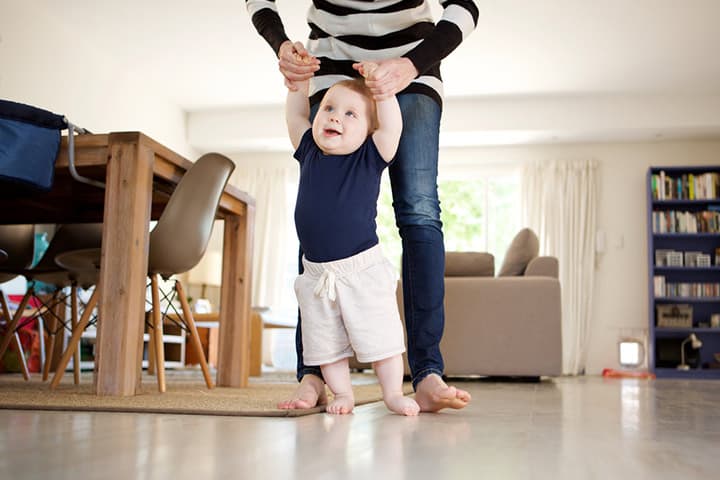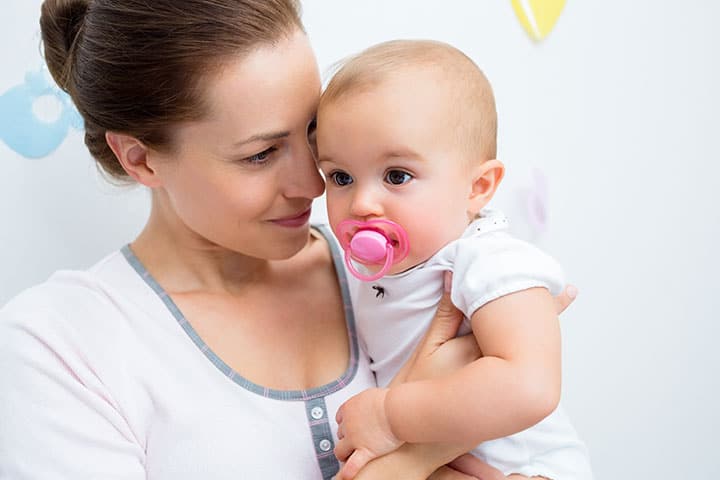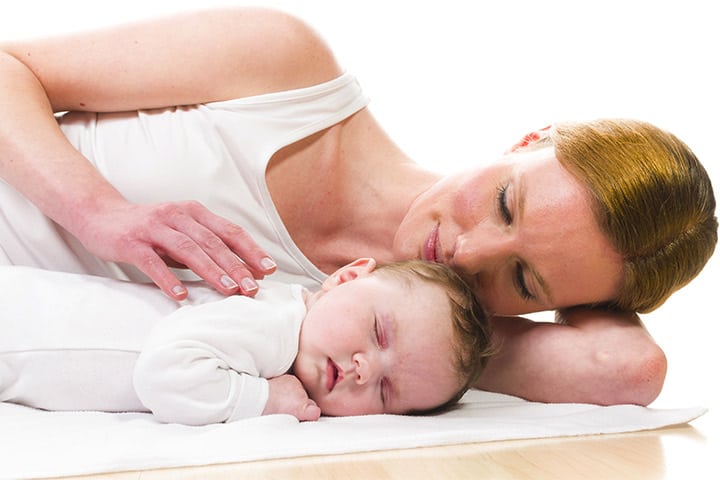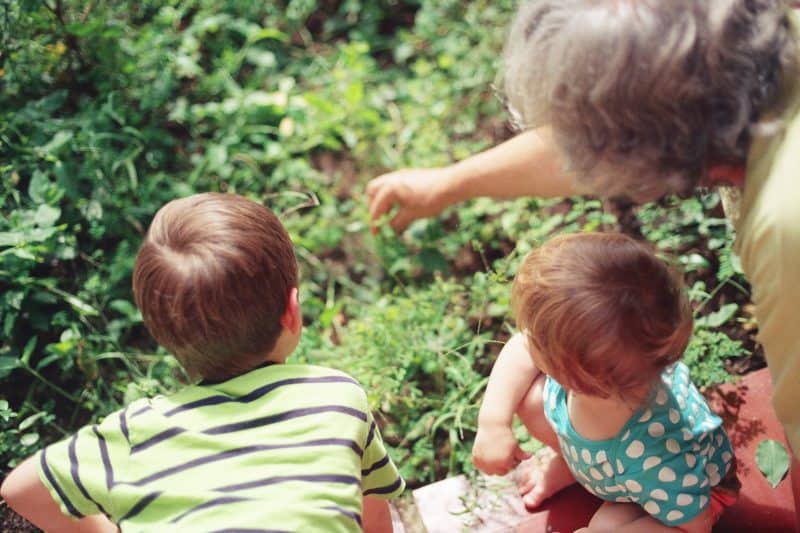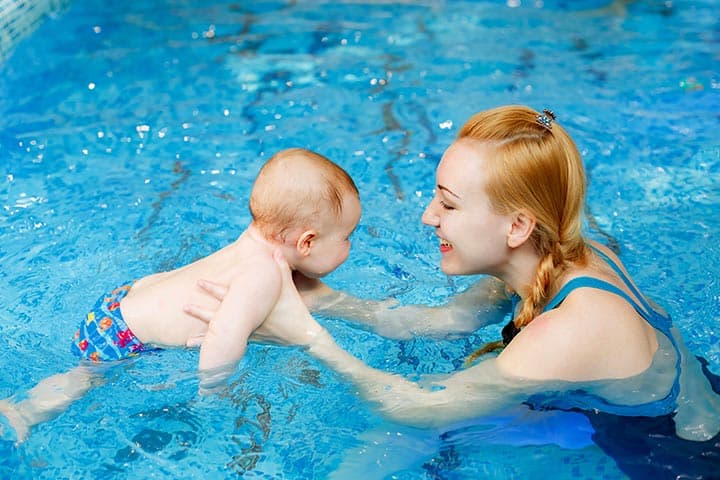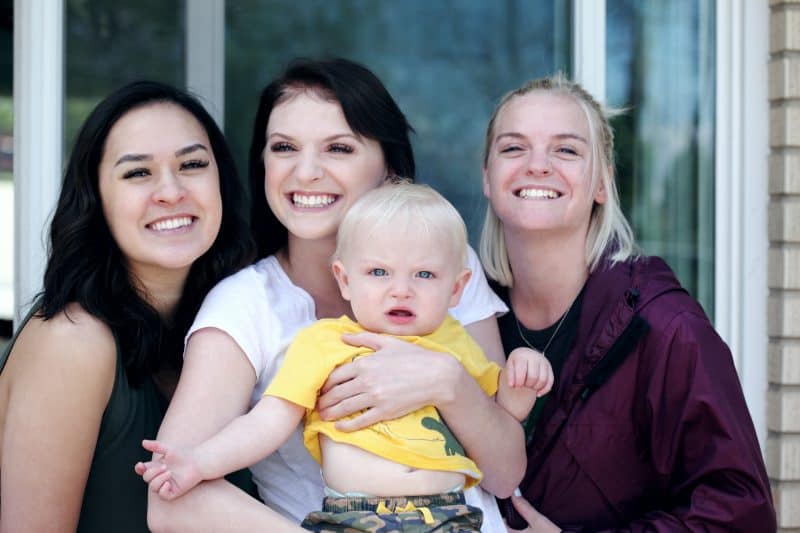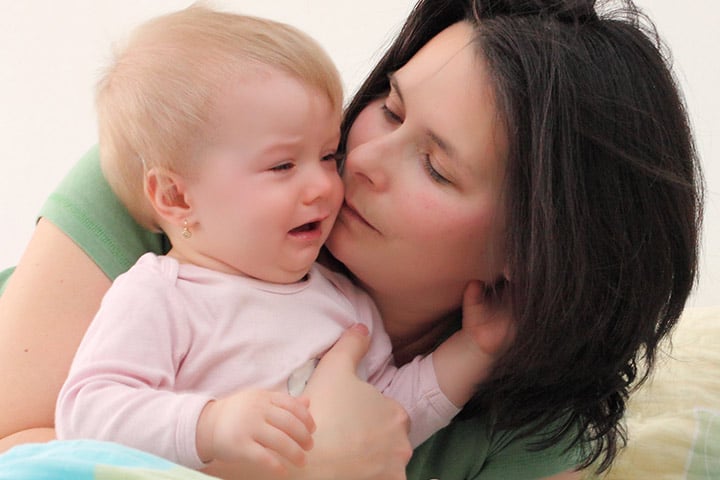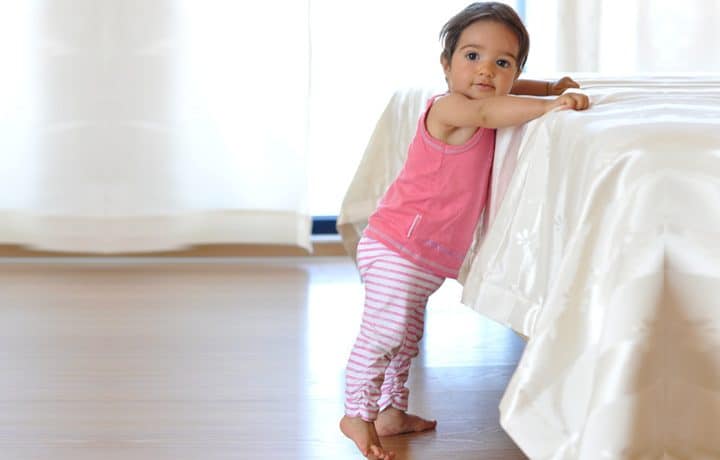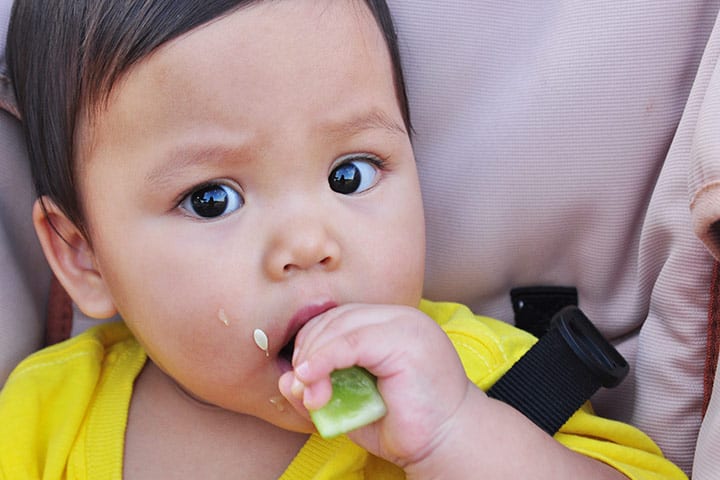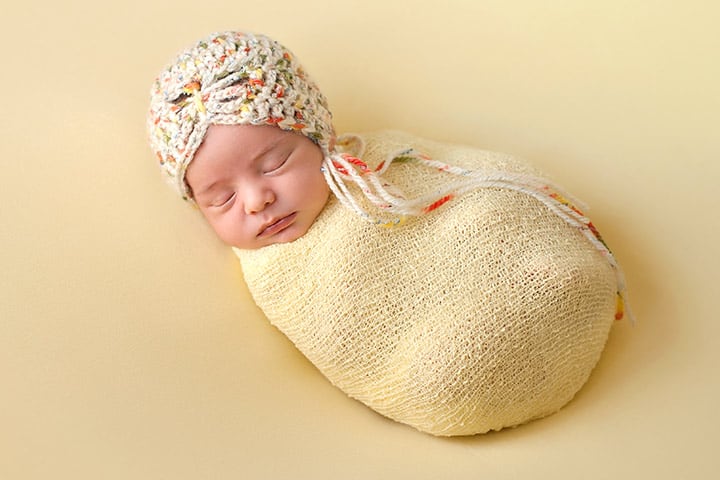You are excited when you see your baby take his first, tiny steps. You can go on those dreamy long walks with your little one, holding his tiny fingers. However, walking does not come overnight and happens through a series of events, which brings us to the question when does a baby start walking?
Walking is a life skill, and just like any other ability, it requires honing through exercises and activities initiated by parents. Here, MomJunction acquaints you with everything about walking in babies and the ways to nurture it.
When Do Babies Start Walking?
By 12 months, the baby takes his first steps with support, and in the next six months, that is by 18 months, he can walk without support (1). Babies attain walking skills by going through a series of events that happen at different stages of the baby’s life.
Stages Of Baby Walking:
An infant will go through the following levels of walking:
-
- Stage one at six months: The precursor to walking is standing. Infants begin to put all their body weight on their feet and stand from six months (2). They cannot get into a standing position yet and need to be held by a parent when standing.
- Stage two at nine months: The next achievement is pulling to stand, which an infant can do by nine months. It is also the period when the baby can stand alone by holding an object for support (3). It is a significant sign that the baby will soon walk.
- Stage three at 11 months: Babies can now walk by holding an object for support (4). The infant can shuffle objects from one hand to another with each step. Such style of walking is referred to as cruising. Cruising becomes better by 12 months (5).
- Stage four from 13-17 months: An intermediate stage where the baby topples, learns, and lifts himself up to walk again. The baby will experiment a lot during this phase and walk in a wobbly manner, hence the name toddler.
- Stage five at 18 months: The infant finally lets go of any crutch or support, and walks for longer distances, mastering the walking skill.
Repeated practice and parental encouragement are the key to ensure the baby acquires walking skills smoothly.
How To Encourage A Baby To Walk?
Here are some simple tips to ensure that your baby’s walking skills stay right on track.
- Stimulate crawling and standing: Children start walking only after they learn to stand. However, they learn crawling way before that. Crawling is the first locomotory movement by the baby and lays the foundation for standing and walking. Encourage crawling since it strengthens the baby’s muscles. You could play games that exercise the lower back and leg muscles.
- Get him on the feet: Once the baby is six months old, spend a few minutes every day holding the baby on his legs. It will help the baby get accustomed to standing. He will learn to balance body mass on both the soles. The weight on the knees will strengthen the joints and stimulate the muscle growth in the legs.
- Place objects that aid standing: There are several support toys specifically designed to bear the baby’s body weight when he stands. Buy one for your baby and put it nearby when he is playing. The baby will grab it to pull himself to a standing position.
- Facilitate cruising: When the baby begins cruising, place support objects around for him to hold. Follow the baby as he cruises, but let him move by himself. The more an infant is cruising to walk, the better he is prepared to walk without support.
- Let him walk without help: When the baby finally goes off support do not fret and rush to grab him. Instead place your hands close as a safeguard while he ambles around slowly on his legs. The baby will learn to balance his body weight on his tiny feet. It is not just his legs at work, but also his brain and inner ear functions that help maintain balance.
Activities And Exercises To Help A Baby Walk
Exercise through activities is a good way to practice walking. Following are some simple activities that will help the baby to walk easily:
1. Reach for the toy
Age for playing: Six months and above
Activity: Make the baby stand on a soft surface while you’re holding him. Ask your partner to hold the baby’s favorite toy a little above eye level, so the baby has to lift his head. Make the baby jump on his feet as your partner prompts the little one to grab the toy. This activity exercises his muscles and joints.
Benefits: Strengthens joints and muscles to support body weight
2. Dance dance baby
Age for playing: Eight months and above
Activity: Play some music, preferably the one your baby likes, and assist the baby to a standing position on a soft surface such as a mattress. Hold the baby’s arms to move his torso for dancing. Since your hands are busy at the baby’s upper body, the legs have to bear the entire body weight alone. The movement of the upper body will change the center of gravity, and the baby will learn to maintain his balance.
Benefits: Helps baby learn balance, strengthens leg muscles
3. Fun with bubble wrap
Age of playing: 11 months and above
Activity: Put a large sheet of bubble wrap on the floor. Put the baby on the bubble wrap and let him hold an object for support. The baby may feel a weird sensation of the bubbles. As he cruises, the bubbles pop under his feet. If he seems confused, step on the sheet yourself and show the baby what happens. The popping and tickling may keep him busy for long!
Benefits: Cruising practice in preparation for full-fledged walking
4. A walk together
Age of playing: 12 months and above
Activity: Go to a garden or beach with your baby and partner. Your partner can hold a hand while you hold another, and walk along with the baby. If you sense he is trying to release his hands from your grip, then let go, but continue walking behind. It is in impromptu moments like these that you realize your baby has become an independent walker.
Benefits: Walking practice, family bonding
Activities help the baby walk, but it is important you take precautions when your baby walks.
Precautions When Baby Is Walking
Keep in mind the below points.
- Do not leave the baby unattended: Never leave the infant alone even if he is 18 months old and can walk by himself as he may tread on a dangerous path. If you are outdoors practicing his walking skills, be extra vigilant. Even at home a baby may accidentally topple over, therefore, always keep an eye on him.
- Start training on a soft surface: Begin the first practice on surfaces such as a rug or mattress. It reduces the strain on the baby’s delicate feet and joints while cushioning him in the case of a fall. As the baby gets better at supporting his body weight, you can move to harder surfaces.
- Do not use baby walkers: The American Academy of Paediatrics recommends against the use of baby walkers since they have no benefits for the baby (6). Instead, the academy recommends using a stationary walker without wheels, which the baby can use for support during cruising. A toy push car is a nice prop to help the baby stand and walk. Ensure that the car has a bar for the baby to hold and is weighted so it does not trip over due to the baby’s weight.
- Prefer barefoot indoors, but use shoes outdoors: When indoors, let the baby walk around barefoot as it gives a sense of the texture of the floor. The little one can have free movements, unbound by shoes. Though being barefoot is best, it does not mean shoes have no benefits. Experts recommend protecting the baby’s feet with shoes when you go outdoors (7). Baby shoes should be flexible, lightweight, and have a soft cushioned inner lining. On the outside, they must have an anti-skid sole to reduce slipping and falling. The feet of an infant grow at a rapid pace, which means he will outgrow his shoes within months. Check the fitting periodically to ensure there are no shoe bites or ill-fitting shoes.
- Do not thrust walking, let it come naturally: Walking is a developmental milestone that the baby attains when the time is right. No amount of practice and parental stimulation is going to make your baby go precocious and learn walking beA baby will show a natural inclination towards walking, showing signs of interest, and that’s when you can begin the training.
It is very important to baby proof the house. It is imperative that you remove all dangerous items strewn across the floor. Tuck away wires and cover pointy edges of furniture. A safer home brings more freedom for the baby to exercise his walking skills.
What If The Baby Does Not Walk?
There could be instances when the baby has a delayed achievement in walking. Here are some salient points about such situations:
- Do not panic: Medical experts state that if a child goes beyond the age of 18 months to learn walking, then it does not necessarily mean a problem (8). The baby can easily catch up later.
- Premature babies may walk later: Full term babies can take their first steps alone at the age of 12 months. However, preterm babies may start doing it at a later age of 15 months (9). Such babies can have an overall delayed normal growth. Regular checkup with a doctor can ensure the preemie achieves all milestones even if delayed.
- Early neonatal infections can lead to delayed development: Infectious diseases in early life may lead to missing a developmental milestone (10). For instance, a lung disease called bronchopulmonary dysplasia can affect the baby’s posture subsequently impacting physical activities such as sitting and walking. This makes it mandatory for the pediatrician to check a baby after every bout of severe illness for a timely diagnosis of any developmental delay.
- Some genetic disorders may delay walking: Genetic disorders such as autism, cerebral palsy, and down’s syndrome can prolong the emergence of physical skills such as walking (11) (12) (13). You can have your baby periodically screened for these problems by a medical practitioner.
Red Flags In Development
Here are the red flags about walking development that you must be on the lookout for:
- By six months: Does not support partial weight on the legs and does not bounce on legs
- By nine months: Does not stand with support of an object and also unable to pull to stand
- By twelve months: Does not cruise (walk with support)
- By eighteen months: Does not walk without the support of an object or a parent holding him
If your baby shows any of these signs, then stay calm and take him to a doctor. It could just be the baby taking time to learn to walk and needs extra time.
Some good ol’ practice through fun and games is all the baby needs to master his walking skills. Once the baby is all set to walk properly, he is going to keep you on your toes and you will have a lot of moments to capture!

